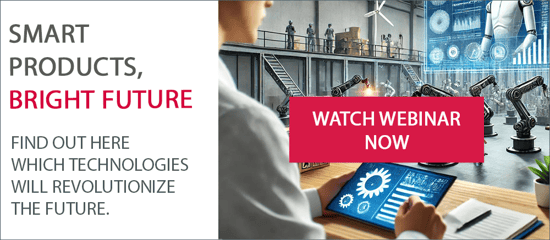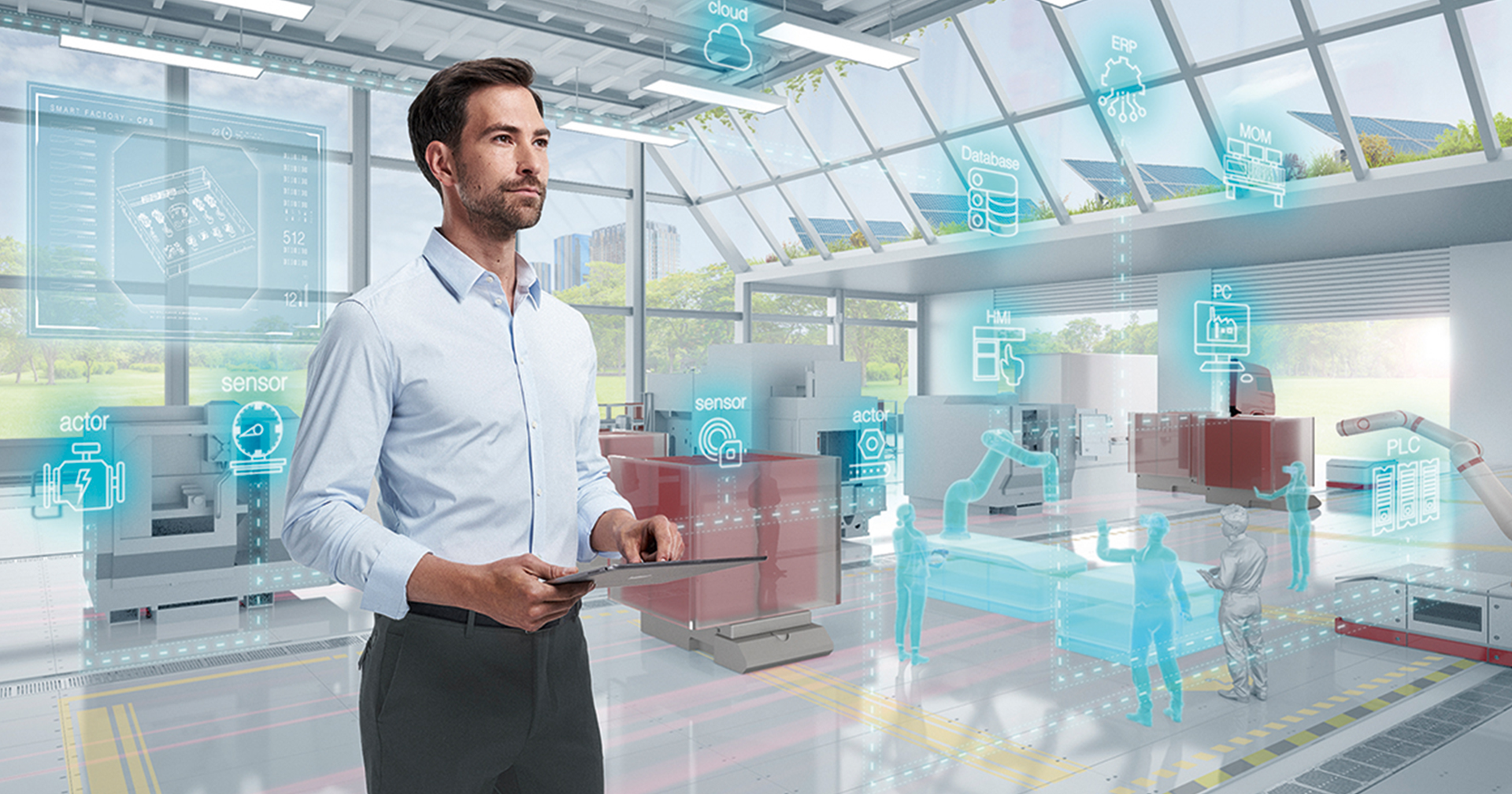Rising production costs, increasingly strict regulatory requirements and growing pressure for sustainability pose major challenges for manufacturing companies. At the same time, expectations for innovative, adaptable and resource-saving products are rising. How can the balancing act between cost-effectiveness and innovation be achieved?
Smart products are the key. They are far more than technical gimmicks - they increase efficiency, reduce costs and ensure competitiveness. With AI-supported development, adaptive interfaces and simulation-based validation, production processes can be designed more efficiently, risks minimized and sustainable product strategies developed. This results in future-proof solutions that can be flexibly adapted to new market requirements.
What is a SMART product?
A smart product is a well thought-out solution that can be flexibly adapted to different requirements. The product does not necessarily have to be digital or electronic - what matters is that it increases efficiency, is designed to be sustainable and offers the user real added value.
Example: A multifunctional tool like a Swiss army knife is mechanical but highly functional, versatile and intuitive to use. In industry, intelligent material selection, modular design and adaptive software solutions can be used to develop genuine Smart products.
They impress with their well thought-out choice of materials, intelligent production and modular expandability. Companies that focus on customer needs and strategic planning right from the development phase can shorten innovation cycles and become more competitive in the long term.
The decisive factors for a SMART product
An intelligent product must fulfill several key aspects in order to be economically successful and technologically future-proof. These success factors are crucial:
1. Clear objectives and added value for users
A Smart product is only truly innovative if it solves a specific challenge. Whether through higher energy efficiency, lower maintenance costs or a longer product service life - technology must not be an end in itself, but must bring measurable benefits.
The key to success lies in the added value for users. It's not about simply integrating technology, but providing targeted functions that make everyday life or the work process easier. But what does this look like in practice? Two examples illustrate this:
- Health and safety technology: Sensor-based wearables record health data in real time and detect anomalies at an early stage - a smart system that can save lives.
- Everyday life and families: Toothbrushes with sensors help children to learn the correct brushing technique and give parents feedback on the effectiveness of dental care.
These examples show: A product is a Smart product if it can be used intuitively and offers real added value.
What makes a product really "smart"? Is it the sensor technology, the networking or the ability to self-optimize? The Smart Product coffee talk provides answers to these questions and offers exciting insights into the future of smart product development.
You can gain even deeper insights live at the Hannover Messe: From March 31 to April 4, 2025, we invite you to Hall 15, Stand F40, where you can experience Smart products such as humanoid robots up close with us.
2. Cost optimization and scalability
A well thought-out Smart product is not only innovative, but also economically viable. Companies must pay attention to optimizing production costs and taking scaling options into account at an early stage during the development phase. Modular systems enable later adaptations and expansions, while flexible interfaces facilitate seamless integration into existing ecosystems. Structured requirements management also reduces expensive rework in the late development process. Concrete examples from the industry:
- System engineering makes it possible to separate the functional and technical specifications of the products (from the overall system to the assemblies and individual parts) as early as the planning phase, which are then tested on digital or physical prototypes based on the corresponding specifications or standards.
- Predictive maintenance: By analysing real-time data, machines detect wear at an early stage and optimize maintenance cycles - this minimizes downtimes and reduces operating costs in the long term.
These examples show how Smart Products are not only technologically impressive, but also create economic added value by increasing efficiency and scalability.
3. Virtual product development and simulation-based validation
Before a Smart product is launched on the market, it should be "tested" digitally. Simulations and virtual prototypes enable early error detection, optimize product quality and reduce development times. Various scenarios can be run through in the Industrial Metaverse to identify optimization potential in real time before physical prototypes are built. This saves time, resources and costs. Two practical examples:
- Test-based validation through simulation-based development: Behavioral models can be used to realistically simulate different operating conditions so that adjustments can be made before the first physical prototype is built. This ensures a more efficient and faster market launch.
- Combination of real sensor data and virtual models: This method enables continuous product improvement over the entire life cycle and increases the long-term performance of the Smart product.
Virtual product development is not just a supplement to traditional methods, but a decisive factor for shorter development cycles, lower costs and higher product quality.

4. Technical connectivity as added value
A Smart product is not automatically better just because it is connected. Connectivity must be used in a targeted manner to create real functional benefits. The decisive factor is that connectivity enables more than would be possible without it - be it through optimized control, predictive maintenance or adaptive further development.
Interfaces and software-supported further development play a central role here. A networked product only remains future-proof if it can be continuously improved and adapted to new requirements through software updates. Let's look at this using a practical example:
- Intelligent grid management: A modern energy system combines various consumers and producers such as solar power systems, battery storage and heat pumps into one intelligent unit. Through real-time data analysis and smart control, the system optimizes the energy flow and reduces costs. The ability to continuously adapt and develop makes this technology valuable in the long term.
5. Sustainability through intelligent product concepts
A Smart product should not only be technologically advanced, but also sustainable and resource-efficient. Environmentally friendly materials, concepts for the circular economy and energy-efficient operating models need to be taken into account as early as the development phase. Digital tools help to analyze the entire product life cycle and make targeted sustainable decisions. Here are some practical examples to illustrate this:
- AI-supported material planning: Artificial intelligence can optimize the use of materials by precisely calculating requirements and predicting which components can be reused or recycled. This allows the CO2 footprint to be minimized over the entire product life cycle.
- Defining a circular economy strategy at an early stage can ensure long-lasting business models. For example, remanufacturing can be used to bring the product back onto the market after an initial life cycle. Taking this remanufacturing process into account in the design ensures low costs
- In addition, our QLCA software enables a quick life cycle assessment (LCA) to evaluate and adjust the carbon footprint of a product as early as the concept phase. Together with our customers, we can then simulate various scenarios and optimize them based on data - from material selection to use and recycling.
Conclusion: Smart products as a driver of innovation
Smart products are more than just technological innovations - they are strategic levers for efficiency, sustainability and competitiveness. Combining simulation-based development with adaptive software solutions and sustainable material concepts not only creates technological advances, but also long-term market opportunities.
The key lies in the intelligent combination of benefits, cost-effectiveness, technical security and meaningful connectivity. Smart products are constantly evolving - be it through resource-saving production, software-supported updates or data-based optimization during operation.
Companies that implement these principles in a targeted manner benefit twice over: not only can they react more quickly to market changes, they can also develop new business models - from data-driven services to sustainable closed-loop systems. Smart products are therefore not a short-term trend, but the key to sustainable market success.
Discover SMART Products with us at the Hannover Messe
Experience the future of smart products and humanoid robots! At the Hannover Messe, we will be showing how innovative technologies are revolutionizing product development in the industrial metaverse.
From March 31 to April 4, 2025, we invite you to discover the next generation of intelligent products, digital transformation and sustainable business strategies in Hall 15, Stand F40.
Would you like to find out more? Then talk to our expert Michael Küpper, Vice President Engineering Smart Product. Or register now for free the recording of the Smart Product Couchtalk and find out how simulation-based development, sustainable concepts and adaptive software solutions are changing the industry. 





